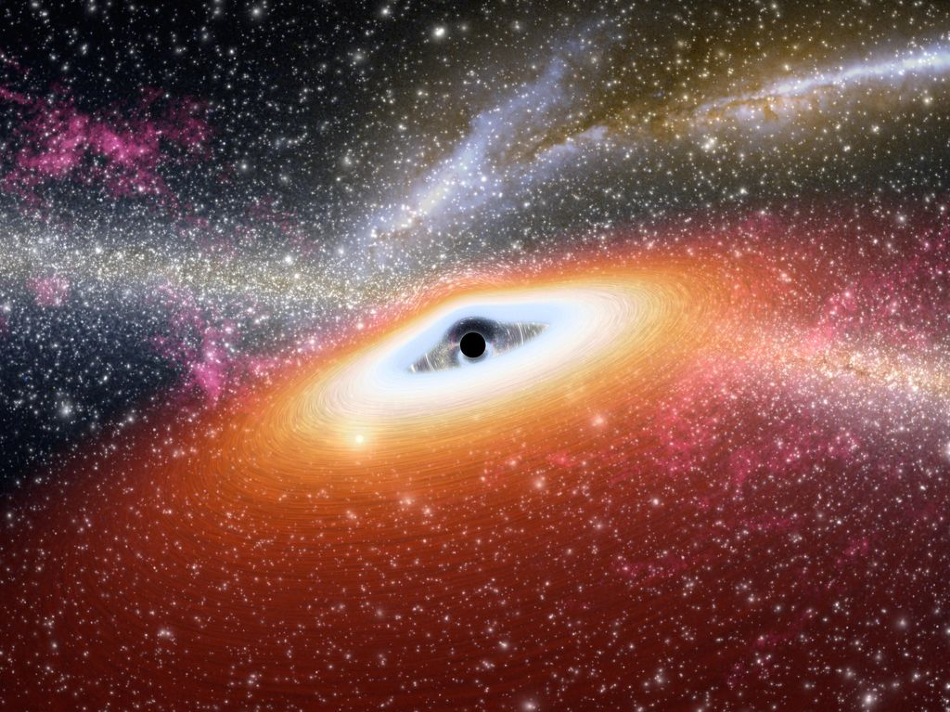Mar 24 2020
Supermassive black holes are billions of times bigger than the Sun, but how is this possible? According to recent observations, these space giants already existed when the Universe was “just” 800 million years old and is currently 14 billion years old.
 According to classical theories, these space giants would not have had the time to develop in the young Universe. Yet, observations say they were already present. A new study by SISSA proposes a response to the fascinating question. Image Credit: NASA/JPL-Caltech.
According to classical theories, these space giants would not have had the time to develop in the young Universe. Yet, observations say they were already present. A new study by SISSA proposes a response to the fascinating question. Image Credit: NASA/JPL-Caltech.
The emergence of these celestial giants in such a brief time poses a real scientific dilemma to astrophysicists, raising significant questions on the present knowledge relating to the formation of these cosmic bodies.
A new article, authored by Scuola Internazionale Superiore di Studi Avanzati (SISSA) PhD student Lumen Boco and his supervisor Andrea Lapi and recently published in The Astrophysical Journal, provides a potential explanation to this tricky problem.
Based on an original model conceptualized by Trieste researchers, the study recommends an extremely rapid formation process during the preliminary phases of the formation of the giant black holes, which, so far, were believed to be slower.
The study results mathematically showed that supermassive black holes could possibly exist in the young Universe and reconciled the timing needed for their development with the limitations imposed by the Cosmos’ age.
Thanks to upcoming gravitational wave detectors such as LISA and Einstein Telescope, the validity of this concept can be completely confirmed, while this was also tested in a number of rudimentary aspects using the present Advanced LIGO/Virgo system.
The Cosmic Monster that Grows at the Centre of Galaxies
The researchers began their analysis with a piece of familiar observational proof—the development of giant black holes that takes place in the core regions of galaxies, progenitors of the present elliptical galaxies, which had an extremely high concentration gas and in which the star formation was very strong.
“The biggest stars live a short time and very quickly evolve into stellar black holes, as large as several scores of solar masses; they are small, but many form in these galaxies,” stated Boco and Lapi.
The duo further explained that the thick gas surrounding the black holes has a very strong definitive effect of dynamic friction and makes them to move quite rapidly to the core of the galaxy. Most of the various black holes that approach the core regions combine and produce the giant black hole seed.
According to classical theories, a supermassive black hole grows at the centre of a galaxy capturing the surrounding matter, principally gas, ‘growing it’ on itself and finally devouring it at a rhythm which is proportional to its mass.
Lumen Boco, PhD Student, and Andrea Lapi, Supervisor and Coordinator, The Astrophysics and Cosmology Group, SISSA
Boco and Lapi continued, “For this reason, during the initial phases of its development, when the mass of the black hole is small, the growth is very slow. To the extent that, according to the calculations, to reach the mass observed, billions of times that of the Sun, a very long time would be required, even greater than the age of the young Universe.”
But the researchers’ study revealed that things could go relatively faster than that.
The Crazy Dash of Black Holes: What the Scientists Have Discovered
“Our numerical calculations show that the process of dynamic migration and fusion of stellar black holes can make the supermassive black hole seed reach a mass of between 10,000 and 100,000 times that of the Sun in just 50-100 million years,” added the researchers.
At this juncture, the scientists stated that “the growth of the central black hole according to the aforementioned direct accretion of gas, envisaged by the standard theory, will become very fast, because the quantity of gas it will succeed in attracting and absorbing will become immense, and predominant on the process we propose.”
Nevertheless, precisely the fact of starting from such a big seed as envisaged by our mechanism speeds up the global growth of the supermassive black hole and allows its formation, also in the Young Universe. In short, in light of this theory, we can state that 800 million years after the Big Bang the supermassive black holes could already populate the Cosmos.
Lumen Boco, PhD Student, and Andrea Lapi, Supervisor and Coordinator, The Astrophysics and Cosmology Group, SISSA
“Looking” at the Supermassive Black Hole Seeds Grow
The study, apart from describing the model and illustrating its efficacy, also suggests a way for testing it: “The fusion of numerous stellar black holes with the seed of the supermassive black hole at the centre will produce gravitational waves which we expect to see and study with current and future detectors”, the scientists explained.
Specifically, the gravitational waves released in the preliminary phases—when the central black hole seed is still small—can be identified using the existing detectors such as Advanced LIGO/Virgo and fully definable by the upcoming Einstein Telescope.
The resultant development phases of the giant black hole can possibly be analyzed due to the upcoming detector LISA, which will be introduced in space around 2034.
In this manner, “the process we propose can be validated in its different phases, in a complementary way, by future gravitational wave detectors,” explained Boco and Lapi.
This research shows how the students and researchers of our group are fully approaching the new frontier of gravitational waves and multi-messenger astronomy. In particular, our main goal will be to develop theoretical models, like that devised in this case, which serve to capitalise on the information originating from the experiments of current and future gravitational waves, thereby hopefully providing solutions for unresolved issues connected with astrophysics, cosmology and fundamental physics.
Andrea Lapi, Supervisor and Coordinator, The Astrophysics and Cosmology Group, SISSA